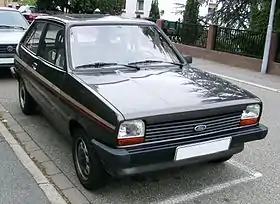
Ford Saarlouis Body & Assembly (SB&A) is a major car plant located on the western edge of Saarlouis in the German Saarland. It belongs to Ford-Werke GmbH, the German subsidiary of the American automaker Ford Motor Company.
History
The construction of the plant started in 1966 on a former airfield. On 16 September 1966, the foundation stone was laid. In 1968, the production of car body panels for Renault started.
The plant commenced car production on 16 January 1970, and was formally opened in the presence of Henry Ford II six months later in June 1970. It was designed to co-produce with Ford’s Halewood plant the company’s recently introduced Escort model, itself intended to compete head-on with Opel’s successful Kadett in the various markets of continental Europe.
At the time the plant was opened, the UK, where the Escort had been produced since the end of 1967, was not part of the European Economic Community and it was not clear whether or when it would join.
In June 2019, Ford announced it would reduce the number of shifts at Saarlouis in an effort to cut costs, as part of a Europe-wide restructuring plan that includes closing several assembly plants in the continent.[1]
In June 2022, Ford announced it will produce its future electric models at Ford Valencia Body and Assembly, leaving the future of the Saarlouis plant past 2025 uncertain.[2]
Current output
| Model | Production Time |
|---|---|
| Ford Focus | 10 August 1998 – present |
Former output
| Model | Production Time |
|---|---|
| Ford Escort | 1970 - 1998 (6,517,352 produced at Saarlouis) |
| Ford Capri | 1971 - 1975 |
| Ford Fiesta | 1976 - 1980 |
| Ford Orion | 1983 - 1990 |
| Ford Focus | 1998 - present |
| Ford Kuga | 2008 - 2012 |
| Ford C-Max | 2015 - 2019 |
The plant produced its 5,000,000th vehicle in 1990 and the 10,000,000th on 1 July 2005.
Gallery
 Escort MkI
Escort MkI Escort MkII
Escort MkII.jpg.webp) Escort MkIII
Escort MkIII Escort MkIV
Escort MkIV Escort MkV
Escort MkV Escort MkVI
Escort MkVI Capri MkI
Capri MkI Fiesta MkI
Fiesta MkI Orion MkI
Orion MkI Orion MkII
Orion MkII Focus MkI
Focus MkI Focus MkII
Focus MkII_%E2%80%93_Frontansicht%252C_17._September_2011%252C_Ratingen.jpg.webp) Focus MkIII
Focus MkIII Focus MkIV
Focus MkIV_2.0_TDCi_front_MJ.JPG.webp) Kuga MkI
Kuga MkI C-Max MkI
C-Max MkI C-Max MkII
C-Max MkII
Employment
Employee numbers reflecting both the changing fortunes of the small family cars produced there and the increasing automation of car production in Europe have evolved as follows:
| Year | Employees |
|---|---|
| 1971 | 5,600 |
| 1978 | 8,100 |
| 1996 | 5,600 |
| 1999 | 6,500 |
| 2002 | 7,200 |
| 2005 | 6,800 |
| 2015 | 6,199 |
In 2005 the plant employed 6,800 workers, organised into three teams. The plant is the largest employer in the Saarland. 79% of the employees were from Germany and 11% from France which is approximately 10 km (6.2 mi) away to the south. There were also significant numbers from Italy and Turkey. 7% of the workforce were female.
Sources and further reading
This entry incorporates information from the equivalent entry in the French Wikipedia
https://uk.motor1.com/news/296339/ford-c-max-cancelled-europe/
References
- ↑ "Ford to slash 12,000 jobs in Europe". Deutsche Welle. Retrieved 28 June 2019.
- ↑ ""We feel lied to and betrayed" - Ford will produce its new e-car models in Valencia" (in German). ARD. Retrieved 23 June 2022.
- "Ford-Werk In Saarlouis: 50 Jahre Automobile Wertarbeit". Ford Media Center. 2020-01-16. Retrieved 2022-03-16.
External links
- Ford Saarlouis from overhead by WikiMaps.
- Ford Saarlouis from overhead by Google Maps.
- The plant's history on the Saarlouis municipal website (in German).
- Ford Germany website (in German).
- Website of the plant trades union, IG Metall at Ford Sarrelouis (in German).
- Website dedicated to the rail-locomotives at Ford Sarrelouis (in German).
